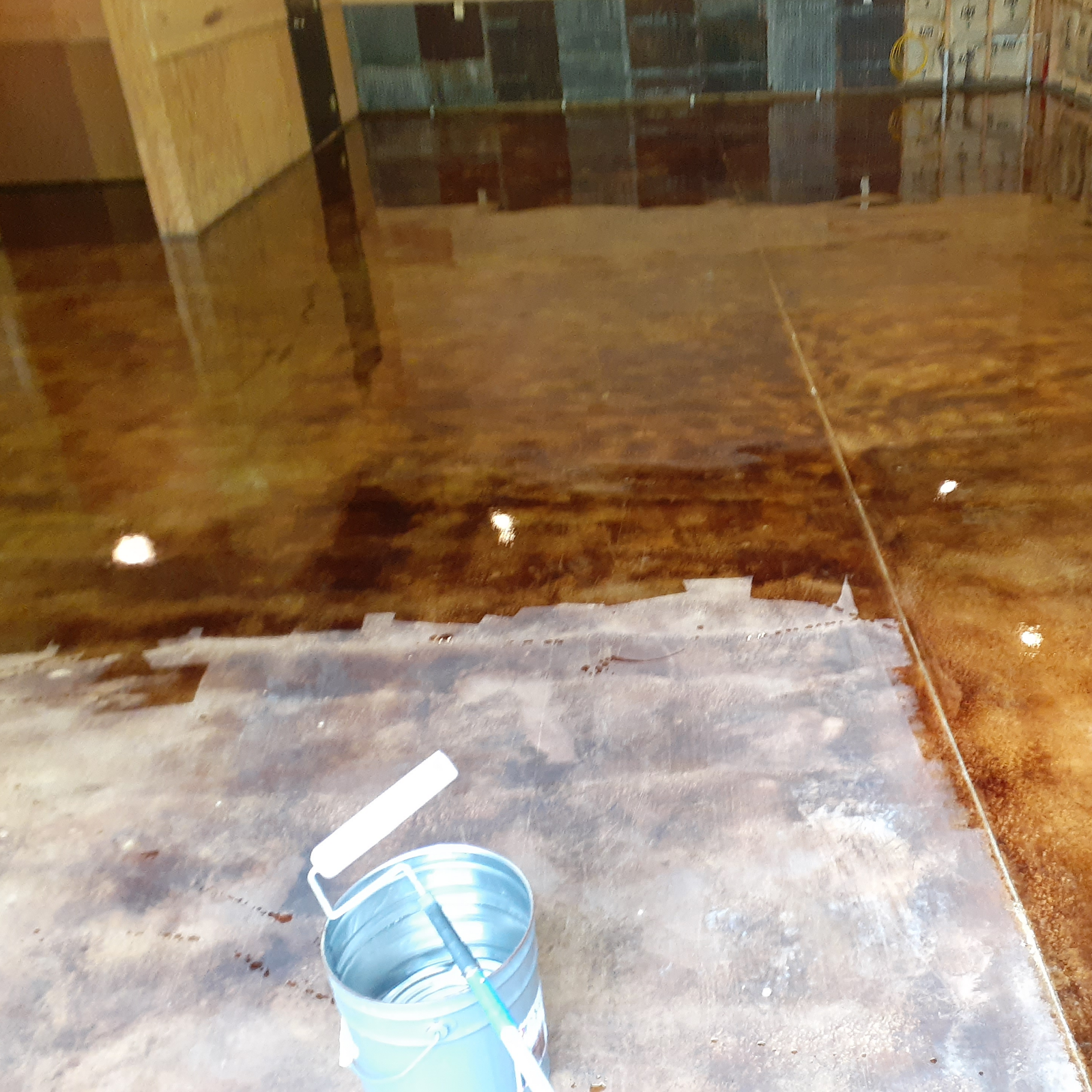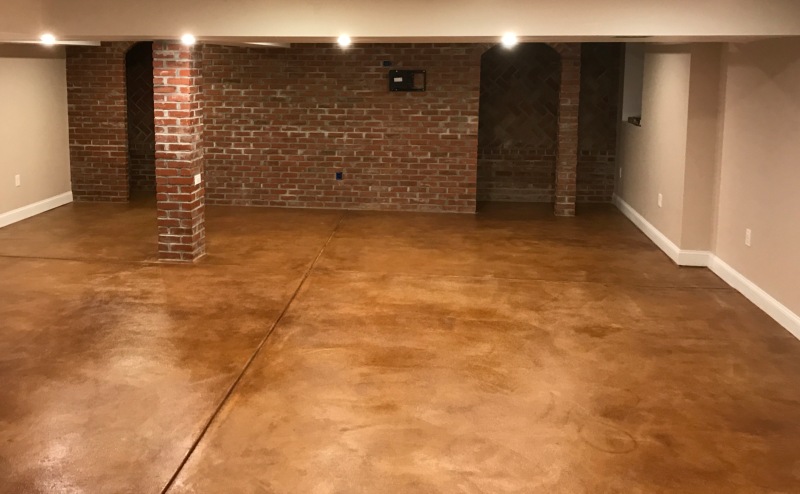The sustainable benefits of stained concrete floors austin
All About Stained Concrete: A Comprehensive Guide to Its Benefits and Applications
Stained concrete has actually arised as a popular option for both household and industrial rooms. Its ability to integrate visual allure with practicality makes it an appealing choice. Numerous discoloration strategies use an array of shades and coatings, permitting for customization. The advantages prolong beyond look. Recognizing its applications and upkeep needs is important for any person considering this versatile material. The nuances of stained concrete invite even more expedition.
What Is Stained Concrete?

Staining can be related to different surface areas, including floors, driveways, and patios, making it a versatile choice for both interior and outdoor areas. The therapy can achieve a variety of looks, from earthy tones to strong, contemporary styles. Unlike paint, stained concrete preserves its look with time, as it comes to be an essential part of the concrete itself. In general, stained concrete works as an efficient technique for transforming average concrete right into aesthetically striking surface areas.
Benefits of Stained Concrete
Stained concrete offers significant advantages, particularly in aesthetic charm and longevity - Stained Concrete Floors Austin Texas. Its vibrant colors and unique patterns enhance the aesthetic beauty of any kind of space, making it a popular choice for both residential and commercial applications. Additionally, the longevity of stained concrete guarantees that it stays a practical investment gradually, resisting damage
Visual Charm
Among one of the most compelling advantages of using stained concrete is its amazing visual allure. Stained concrete deals an one-of-a-kind and flexible look that can complement numerous style styles, from modern to rustic. The infusion of vivid shades and detailed patterns enables home owners and developers to create customized surface areas that can enhance the total ambiance of a space. Unlike conventional floor covering choices, stained concrete can mimic the look of all-natural stone or sleek marble, supplying an upscale look without the linked expenses. In addition, the glossy coating choices can reflect light, additional lightening up interiors. This versatility makes stained concrete a popular choice for both household and commercial applications, where aesthetic influence is critical.
Toughness and Longevity
The excellent aesthetic high qualities of stained concrete are complemented by its impressive resilience and long life - Stained Concrete Austin. Stained concrete surface areas are resistant to damage, making them suitable for high-traffic areas both indoors and outdoors. Their durable nature implies they can hold up against severe climate condition, including severe temperatures, rainfall, and UV exposure, without substantial destruction. In addition, stained concrete needs very little maintenance compared to various other flooring choices, as it does not need frequent sealing or redecorating. This longevity not just decreases substitute costs but also adds to a sustainable building technique. On the whole, stained concrete gives a long-lasting remedy that incorporates aesthetic allure with sensible advantages, ensuring its value in time
Different Sorts Of Staining Strategies
Various discoloration strategies can considerably affect the aesthetic qualities of concrete surface areas. The 3 main techniques include acid staining, which responds chemically with the concrete, water-based discoloration, which uses a wider variety of colors, and overlay staining alternatives that provide a fresh surface. Each strategy has one-of-a-kind characteristics and applications that satisfy numerous layout choices and job requirements.
Acid Discoloration Technique
Exactly how can property owners transform simple concrete surface areas into visually striking attributes? One reliable technique is acid staining, a popular strategy that enhances the all-natural appeal of concrete. This process entails applying a solution of water, hydrochloric acid, and metal salts to the concrete surface area. As the acid reacts with the lime present in the concrete, it creates abundant, variegated shades that resemble marble or rock. Acid staining is understood for its sturdiness and resistance to fading, making it a lasting selection for both indoor and exterior applications. It is necessary to note that the outcomes can vary based on the initial concrete shade and texture. Appropriate application and securing are important for attaining the desired aesthetic and long life
Water-Based Staining Strategy
A popular option to acid discoloration, the water-based staining method supplies property owners a functional method to boost concrete surfaces. This approach utilizes water-soluble dyes and pigments, permitting a vast array of shades and surfaces. Unlike acid discolorations, water-based stains can be used to unsealed concrete and offer a less complicated cleaning process. The results can attain a much more consistent look and can be layered to develop one-of-a-kind effects. In addition, water-based spots are generally much less hazardous and discharge fewer volatile natural substances (VOCs), making them a lot more eco pleasant. Home owners might appreciate the capability to tailor their concrete surfaces with various shades, enabling creative expression while maintaining resilience and durability in their flooring choices.
Overlay Discoloration Options
Many overlay staining alternatives exist for house owners wanting to rejuvenate their concrete surface areas. One popular selection is acid staining, which reacts chemically with the concrete to generate rich, variegated shades. One more option is water-based discoloration, using a broader shade palette and less complicated application. Furthermore, concrete overlays can be incorporated with stencils for detailed styles, enhancing visual appeals. For a more distinctive finish, house owners may take into consideration using stamped overlays that simulate all-natural materials like rock or floor tile. Each method gives distinct advantages, from resilience to customization, enabling for a personalized touch. Eventually, the selection of overlay staining relies on the preferred appearance and the condition of the existing concrete, ensuring a refreshed and enticing surface.
Applications of Stained Concrete
Stained browse around here concrete offers a functional solution for different applications, enhancing both aesthetic allure and performance. This material is frequently used in residential, business, and industrial settings, making it a preferred selection among engineers and developers. In homes, stained concrete can act as fashionable floor covering or outside patios, offering an advanced look while staying durable.
In industrial areas, such as retailers and dining establishments, stained concrete adds to a modern ambiance and can withstand heavy foot traffic. Additionally, stained concrete is increasingly utilized in public spaces like parks and walkways, where its capacity to resemble all-natural rock or various other materials adds visual interest.
Stained concrete is optimal for pool decks and driveways, using a slip-resistant surface area that is simple to preserve. In general, the versatility of stained concrete makes it ideal for numerous environments, catering to diverse tastes and requirements.
Maintenance and Care for Stained Concrete
Proper upkeep ensures the longevity and beauty of stained concrete surfaces. Routine cleaning is vital; utilizing a moderate detergent and water with a soft-bristle brush aids get rid of dust and grime without harming the surface. It is a good idea to avoid severe chemicals that can remove the tarnish or sealant.
Securing you can try here stained concrete is vital for defense against wetness, stains, and use. A high-grade sealant needs to be reapplied every one to 3 years, depending on the web traffic and direct exposure the surface sustains. Additionally, attending to spills promptly will stop discoloration and discoloration.

Expense Considerations for Stained Concrete Projects
When intending a discolored concrete project, spending plan considerations play a vital role in determining the total expense. The costs connected with stained concrete can differ significantly based on several elements. The dimension of the area to be stained directly influences product and labor expenses. Larger areas will normally require even more resources. Second, the type of tarnish chosen-- acid-based or water-based-- can influence pricing, with acid spots typically being more pricey. Additionally, the intricacy of the design, including patterns or numerous colors, can raise labor expenses. Preparation job, such as cleaning and grinding the concrete surface area, adds to the preliminary expenses also. Ultimately, the choice in between do it yourself installment and working with a specialist service provider will further influence the budget. Comprehending these variables makes it possible for property owners to make enlightened economic choices concerning their stained concrete tasks, guaranteeing they achieve the desired aesthetic within their monetary ways.
Tips for Selecting the Right Stained Concrete for Your Area
Choosing the ideal stained concrete for a specific space involves careful consideration of numerous variables beyond simply budget plan. Initially, one must examine the designated usage of the area. High-traffic areas may require more resilient surfaces, while decorative applications can prioritize appearances.
The shade combination is one more vital aspect; the picked colors must balance with existing design and lighting. It's additionally vital to take right into account the surface texture, as smooth coatings can improve elegance, while textured alternatives might guarantee safety in damp areas.
Local environment and ecological conditions play a considerable role in the long life and upkeep of stained concrete, influencing the choice of sealants and surfaces.
Finally, seeking advice from experts can offer valuable understandings tailored to certain requirements, assuring the choice of the perfect stained concrete that straightens with both performance and design.

Regularly Asked Questions
Can Stained Concrete Be Applied Over Existing Floor Covering?
Stained concrete can indeed be applied over existing flooring, provided the surface is steady and properly prepared. This method enables for a visual upgrade without the requirement for full removal of the original floor covering materials.
How Lengthy Does Stained Concrete Last?
Stained concrete can last for years when effectively preserved. Elements such as traffic, ecological conditions, and application techniques significantly affect its durability, with numerous installations continuing to be lively and intact for 10 to 30 years.
Is Stained Concrete Slippery When Damp?
Stained concrete can be slippery when damp, as the surface may develop a smooth surface. Using non-slip ingredients or distinctive finishes can minimize this problem, enhancing security without compromising the visual appeal of the concrete.
Can I Tarnish Concrete Myself, or Should I Employ a Specialist?
The decision to stain concrete directly or hire a professional depend upon skill degree and project intricacy. While do it yourself staining can conserve money, professionals assure ideal outcomes, particularly for intricate layouts or large surface areas.
What Color styles Are Available for Stained Concrete?
The variety Discover More Here of shades available for stained concrete includes earthy tones like browns and tans, vibrant shades such as reds and blues, and softer tones like pastels. This palette enables creative, tailored style alternatives.